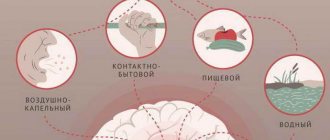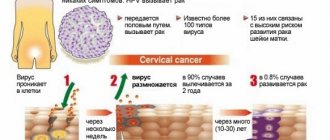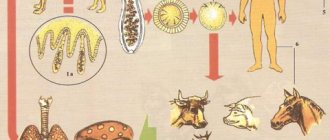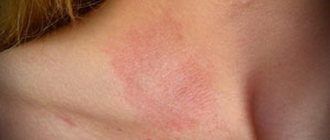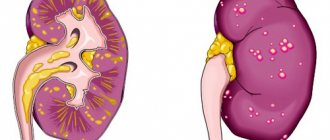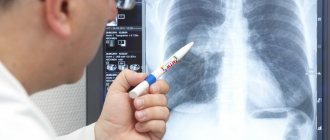Without specific treatment - the introduction of a rabies vaccine - the disease is fatal. The sooner a person seeks medical help after a bite, the less likely they are to get sick. Let's get acquainted with the causes and signs of rabies in people, talk about the principles of its diagnosis and treatment, as well as how to avoid this dangerous disease.
Pathogenesis
The virus is unstable in the external environment - it dies when heated to 56 ° C in 15 minutes, when boiled - in 2 minutes. Sensitive to ultraviolet and direct sunlight, ethanol and many disinfectants. However, it is resistant to low temperatures and phenol.
The virus multiplies in the nerve cells of the body, forming Babes-Negri bodies. Viral copies are transported through neuronal axons at a rate of approximately 3 mm per hour. Reaching the spinal cord and brain, they cause meningoencephalitis. In the nervous system, the virus causes inflammatory, dystrophic and necrotic changes. Death of animals and humans occurs due to asphyxia and cardiac arrest.
What causes rabies?
Rabies causes a specific encephalitis (inflammation in the brain). The virus infects the brain and ultimately leads to death .
After a bite from a rabid animal, the virus multiplies in the muscles and subcutaneous tissue.
In most cases, the virus remains close to the site of exposure during the incubation period (usually one to three months). then travels through peripheral nerves to the brain and from there to almost every part of the body.
Any mammal can spread rabies . It is most often transmitted through the saliva of bats, dogs, foxes, raccoons and skunks.
In Russia, stray dogs are the most likely animal to transmit rabies. The virus has also been found in cows, cats, ferrets and horses.
The local health department is usually constantly monitoring and has information about which animals in a given area have been found to have the rabies virus.
Symptoms of rabies in humans
The incubation period of rabies ranges from 10 days to 3-4 (but more often 1-3) months, in some cases up to one year, that is, the virus can exist in the body without showing symptoms. In immunized people it lasts on average 77 days, in non-immunized people it lasts 54 days.
Isolated cases of extremely long incubation periods have been described. Thus, it was 4 and 6 years after immigration to the United States for two immigrants from Laos and the Philippines; The virus strains isolated from these patients were absent from animals in the United States, but were present in the regions of origin of the immigrants. In some cases of a long incubation period, rabies developed under the influence of some external factor: a fall from a tree 5 years after infection, an electric shock 444 days later.
The duration primarily depends on the location of the injury. The longer the virus has to get to the brain, the longer a person will remain outwardly healthy. In medicine, cases have been described in which the disease manifested itself even 4 years after the bite of an infected cow.
Rabies in humans goes through three stages of development, each of which manifests itself with different symptoms.
Symptoms and signs (photos)
Photos of people with the rabies virus who are no longer ill.
The first symptoms of rabies in humans can appear quickly, within 1 week after infection.
The first signs of rabies in humans are very general and include weakness, high temperature, fever and headaches . Without a history of potential exposure to a rabid animal, these symptoms would not raise suspicion of rabies because they are very similar to the common symptoms of influenza or other viral illness.
The disease can take two forms:
- In paralytic rabies (about 20% of cases), the patient's muscles slowly become paralyzed (usually starting at the site of the bite). This is a less common form and ends in coma and death.
- In cases of frenzied rabies (about 80% of cases), the patient exhibits classic symptoms of rabies, such as: panic, anxiety and confusion (the patient is often overly active);
- encephalitis, causing hallucinations, confusion and coma;
- salivation;
- hydrophobia (fear of water);
- difficulty swallowing.
The disease is almost always fatal. As soon as clinical signs of rabies appear in a person, he dies (see photo of the consequences above).
Diagnostics
Diagnosis is based on medical history: an animal bite or salivation of the skin. Then specific signs of rabies play a role: fear of hydrophobia, increased sensitivity to irritants (sounds, light, drafts), excessive salivation, attacks of psychomotor agitation with convulsions (even in response to the slightest movement of air).
Laboratory methods include the detection of rabies virus antigens in imprints from the surface of the cornea. A blood test reveals leukocytosis due to an increase in the content of lymphocytes. After the death of the patient, an autopsy reveals Babes-Negri bodies in the brain.
General information about the infection
Rabies is an acute viral infectious disease. Sources of infection are wild animals with rabies (wolves, foxes, raccoon dogs, bats, arctic foxes, skunks, jackals) and domestic animals (dogs, cats, pigs, horses, cattle and others), as well as sick people.
It is believed that the rabies virus can accumulate in the bodies of small rodents, which can serve as reservoirs (storages) of rabies in nature.
In the Russian Federation, the main animals in which rabies is registered are foxes and dogs. An animal with rabies behaves aggressively, tries to rush at people, may suffer from attacks of convulsions and hydrophobia, an important symptom is profuse salivation, saliva can be constantly released, burying the ground around, forming foam around the mouth. It is dangerous to get saliva (saliva) on damaged skin (scratches, wounds), since saliva contains a large amount of the rabies virus.
There are also natural and urban types of rabies , caused, respectively, by wild and farm animals. The main route of transmission is contact (a bite or salivation on the skin of a sick animal), infection is also possible by eating contaminated meat, transplacentally (from mother to fetus) and even by airborne droplets (if safety precautions are violated in virology laboratories, in caves with a large number of bats and lack of ventilation, accounts for a small percentage of cases, however, it does occur). Some cases of rabies infection have occurred through cornea transplants from deceased people.
Driver characteristics
The causative agent of rabies is a virus.
Penetrating through damaged skin, the rabies virus travels perineurally (along the membranes of nerve fibers), as well as through the blood and lymph flow, into the central nervous system (centripetally), reaching the substance of the brain. The rabies virus is found in all structures of the brain, however, its favorite location is the medulla oblongata. By multiplying in nerve cells, the rabies virus causes their death, forming zones of necrosis (death) of nervous tissue. Further, along the nerve fibers, it rushes to the periphery (centrifugally), affecting the nervous system, internal organs and salivary glands (therefore, the virus can be released into the external environment with the patient’s saliva). The rabies virus is destroyed by exposure to ultraviolet radiation, direct sunlight, alcohol, drying and regular doses of disinfectants.
Immunity to the rabies virus occurs only after vaccination , providing a protective level of antibody proteins for about three years, then repeated administration of the vaccine (re-vaccination) is required. Vaccine immunization is routinely carried out for persons whose professional activities involve a high risk of contracting rabies.
Treatment of rabies in humans
Until 2005, there were no known effective treatments for rabies once clinical signs of the disease appeared. I had to limit myself to purely symptomatic means to alleviate the painful condition. Motor agitation was relieved with sedatives, and convulsions were eliminated with curare-like drugs. Respiratory disorders were compensated by tracheostomy and connecting the patient to an artificial respiration apparatus.
In 2005, there were reports that a 15-year-old girl from the United States, Gina Gies, was able to recover from infection with the rabies virus without vaccination, when treatment was started after the appearance of clinical symptoms. During treatment, Gis was put into an artificial coma, and then she was given drugs that stimulate the body's immune activity. The method was based on the assumption that the rabies virus does not cause irreversible damage to the central nervous system, but causes only a temporary disruption of its functions, and thus, if you temporarily “turn off” most of the brain functions, the body will gradually be able to produce enough antibodies to defeat virus. After a week of being in a coma and subsequent treatment, Gis was discharged from the hospital several months later without signs of being affected by the rabies virus.
However, rabies is incurable in its final stages. The probability of death if infected is 99.9%.
What to do if bitten by a dog - first aid
Although rabies is considered an incurable disease, it is possible to prevent its further progression. To do this, after an animal bite, you need to contact a medical facility as soon as possible.
You should not wait until the first symptoms of infection begin to appear - this can be deadly. It is important to act before the virus enters the brain or central nervous system.
The very first aid for a person bitten by a dog is intensive washing of the wound using a disinfectant. Do not cauterize the bite site or apply stitches yourself.
After washing, it is necessary to apply a viulicidal drug (povidone-iodine solution). When going to the hospital, a person will be given a course of injections - immunoglobulins.
Treatment after a bite
For further human treatment, rabies vaccines are used:
- HDC;
- PCEC;
- VERORAB.
The injections are given strictly according to the schedule: in the first hours, on the 3rd, 7th, 14th, 30th day and three months after the incident. Another serum is administered throughout the year. During the immunization period, it is extremely important to follow the doctor's instructions. In addition, stress and colds should not be allowed at this time.
If a person has been bitten by a dog vaccinated against rabies, the doctor may change or stop treatment altogether. If, after being bitten, the dog lives longer than 10 days and does not show symptoms of rabies, the doctor will raise the question of stopping treatment (since this is simply not necessary).
Features of vaccination
Since treatment of rabies at the stage when symptoms appear is no longer effective, to prevent the spread of the virus, prevention of the disease is required by administering a special vaccine.
Rabies vaccinations are prescribed to humans in the following cases:
- if he was injured by objects on which there was saliva of an infected person;
- if he was attacked by an obviously unhealthy animal and received open injuries to the skin;
- if he has been bitten by wild rodents;
- if he was exposed to the saliva of a patient with a pathology such as rabies, a person, and in other cases when the saliva of the alleged carrier could get into an open wound;
- if he has scratches on his body resulting from contact with an animal, which died soon after they were inflicted for an unknown reason.
Rabies vaccinations are prescribed immediately, at regular intervals. They are carried out both on an outpatient and inpatient basis - depending on the patient’s wishes and the severity of the bites.
It should be remembered that vaccination can cause side effects, such as redness of the injection site, increased body temperature, dyspeptic disorders, and general condition. There are special instructions regarding rabies vaccination and alcohol intake - to prevent the development of post-vaccination complications, people are prohibited from drinking alcohol during the vaccination period and six months after it.
When is infection possible?
What does medicine know about how you can become infected with rabies: a person is at risk after being bitten or scratched by a sick animal, as well as through saliva when it comes into contact with mucous membranes.
Both wild or feral animals and pets can be dangerous. Potential carriers, one way or another, belong to the group of warm-blooded mammals.
Pets often become infected during fights or after being attacked by other animals on the street.
Thus, among pets, dogs and cats are most at risk. If the cat is completely domestic, does not leave the house and does not come into contact with other animals, then there is nothing to fear. But, if the cat is walking or walking on its own, then upon returning home it should be examined for scratches, bites and wounds.
Important! Rabies is transmitted from a cat to a person through a bite or scratch, as well as from saliva.
Sometimes even an infected animal can be a carrier of the so-called “dormant” virus and infection will not occur in the human body.
Some wonder whether the disease is spread from person to person . As a rule, this cannot happen. There may be isolated cases when contact is made with someone who is known to be sick and saliva enters the body of another person.
However, even in this case, the likelihood of infection is extremely low. The situation may be different when an organ is transplanted from a sick person to another healthy person. However, taking into account the statistics of the disease and a whole range of preliminary examinations, the likelihood of such an incident is also practically excluded.
Prevention
Specific prevention is carried out by conducting a course of combined administration of rabies vaccine and rabies immunoglobulin after being bitten or salivated by an animal. After a bite, you should treat the wound and consult a surgeon.
Wound treatment is carried out as follows:
- wash the wound generously with boiled soapy water or hydrogen peroxide;
- treat the wound with iodine or 70° alcohol;
- suturing the wound, as well as excision of its edges, is contraindicated;
- Anti-rabies immunoglobulin is injected around the wound and into the wound itself;
- after 24 hours, anti-rabies serum is injected.
The first two points of treatment should be carried out at home, even before visiting the doctor; the rest is carried out by the surgeon.
Signs of rabies
How does rabies progress?
Before the onset of clinical manifestations, the incubation period of rabies passes, that is, the time required for the virus to penetrate the cells of the nervous system and the beginning of their pathological changes - in order for signs of rabies to appear. On average, the incubation period of rabies takes 1 - 3 months, but can range from 12 days to a year or more. This is due to the location of the bite - the closer the bite is to the brain, the faster the disease develops, therefore, if the head, neck, or arms are damaged, it is necessary to begin preventive measures to prevent rabies as soon as possible. The course of the disease has three stages: the initial, or stage of depression (about 1 - 3 days), the stage of excitement (2 - 3 days) and the paralytic (terminal) stage (several hours - a day). Most often, the entire course of the disease (from initial manifestations to death) takes about 10 days.
Specifics of the clinical picture
Rabies causes specific symptoms in humans.
Unpleasant sensations at the site of the bite. Even with a completely healed injury, nagging pain, increased sensitivity of the skin, itching, burning, and tingling sensation occur in the area of the former wound. If there is a scar, it may become red and swollen.
Fever. The initial period of rabies occurs with a slight increase in body temperature, later the fever increases to high numbers.
Hallucinations. Olfactory, visual, and auditory hallucinations, especially with bites to the face, are common symptoms of rabies. Patients often complain of nightmares.
Behavioral changes. At first, patients with rabies become withdrawn, apathetic, are in inexplicable fear, anxiety, depression; as the disease progresses, their behavior can become unnaturally cheerful, with fits of violence at the height of the attacks, they can spit, bite, and tear their clothes. Patients' breathing is noisy, they complain of lack of air, tightness in the chest.
Cramps. Convulsions, as obligatory symptoms of rabies, occur in bright light, loud sound, even with a slight blow of wind towards the patient. During convulsions, a person’s gaze is fixed at one point, the facial expression is pained, frightened, and there may be vomiting.
Rabies. Due to the spasm of the muscles of the larynx at any mention or sight of water, the disease received its second name. However, colored liquids (tea, coffee, juice) do not cause attacks.
Profuse sweating and salivation. Or the so-called sialorrhea, a painful, incessant release of saliva from the patient’s mouth, as well as profuse sweating until clothing and bed linen are soaking wet.
Stage of imaginary well-being. Due to depression of brain activity, a few days after the onset, the attacks stop, and the last stage of the disease begins, which outwardly looks like an improvement. Paralysis of the tongue, face, and muscles of the limbs occurs. Death occurs due to paralysis of the respiratory center in the brain, as well as from cessation of cardiac activity due to paralysis of the heart muscle.
The disease can begin immediately with attacks, and in children, rabies can occur without attacks of hydrophobia; the symptoms of rabies are only apathy, lethargy, drowsiness and fever; the death of a child with rabies can occur within a day from the onset of the disease.
How to prevent rabies
Rabies is a preventable disease. There are a few simple steps you can take to avoid contracting rabies:
- Receive a rabies vaccination before traveling to developing countries, working in close contact with animals, or working in a laboratory that processes the rabies virus.
- Vaccinate your pets.
- Report stray animals to animal control.
- Avoid contact with wild animals.
- Keep bats away from living spaces or other structures near your home.
You should report any signs of an infected animal to your local animal control or health departments.
Historical facts
Rabies existed on planet Earth even before our era, and to this day humanity has not come up with a way to destroy the circulation of the pathogen in nature. The name of the disease comes from the word “demon.” This is exactly how the clinical symptoms of the disease were interpreted in ancient times, believing that a demon was possessing a person. There are some countries where rabies is not recorded: Great Britain, Norway, Sweden, Japan, Finland, Spain, Portugal, New Zealand, Cyprus (mostly island states). Until July 6, 1886, all cases of the disease were 100% fatal. It was on this day that a specific anti-rabies vaccine (Rabies - rabies in Latin), created by the French scientist Louis Pasteur, was first used. Since then, the fight against the disease began to end in victory (recovery).
Symptoms
The incubation period for rabies is long, from 1 to 6 months. With extensive wounds and massive infection, the incubation period can be reduced to 9 days. For bites of the face, head and neck, the latent period is short, for bites of the lower extremities it is longer. Cases of the development of rabies a year or more after being bitten have been described.
In the rabies clinic, there are 3 periods of the disease:
- premonitory;
- period of excitement;
- period of paralysis.
In the prodromal period of the disease, aching pain appears in the area of salivation or bite, even if the wound has already healed. Redness of the scar, itching and burning may occur.
The child's temperature rises to within 38°C, headache, nausea, and vomiting may occur. The child refuses food, his sleep is disturbed (insomnia appears). If the baby does fall asleep, then he sees frightening dreams.
During this period, the child is withdrawn, indifferent to what is happening, the mood is depressed and anxious. The facial expression is sad. The teenager is worried about an unfounded feeling of fear, heaviness in the chest, accompanied by increased heart rate and breathing.
The duration of the prodromal period is 2-3 days (can extend up to 7 days). Subsequently, mental disorders intensify, depression and indifference are replaced by anxiety.
During the period of excitement, the most characteristic symptom of rabies appears: hydrophobia (or hydrophobia). When a patient tries to swallow any liquid, even saliva, a muscle spasm of the larynx and pharynx occurs.
The sight and even the sound of pouring water, and even talking about water, causes a feeling of fear and the development of such a spasm. When trying to give the patient something to drink, he pushes the cup away, bends over, and throws his head back.
At the same time, the patient’s face turns blue and expresses fear: the eyes are somewhat bulging, the pupil is dilated, the gaze is directed at one point, breathing is difficult, sweating increases. Although the attacks of convulsive muscle contraction are short-lived (lasting a few seconds), they are often repeated.
An attack can be triggered not only by the sight of a liquid, but also by a stream of air, a loud knock or sound, or a bright light. Therefore, the patient develops not only hydrophobia (hydrophobia), but also aerophobia, acoustic phobia, and photophobia.
In addition to increased sweating, there is abundant formation and secretion of saliva. Psychomotor agitation and manifestations of aggression and rage occur. Patients can bite, they spit, they can hit, they can tear their clothes.
It is precisely this kind of inappropriate violent and aggressive behavior that is meant when people say: “behaves like mad.”
During an attack, there is confusion and frightening visual and auditory hallucinations. Between attacks, consciousness may become clearer.
Vomiting, sweating and drooling, and the inability to take fluids lead to dehydration (this is especially pronounced in children) and weight loss. The temperature may remain elevated.
The period of excitation lasts 2 or 3 days, less often up to 5 days. At the height of any of the attacks, respiratory and cardiac arrest may occur, that is, death.
In rare cases, the patient may survive until the third period of the disease - the period of paralysis. Seizures at this stage stop, the patient can already drink and swallow food. Hydrophobia disappears. Consciousness during this period is clear.
But this is an imaginary improvement. Body temperature rises above 40°C. The pulse increases, blood pressure progressively decreases. Excitement gives way to lethargy. Depression and apathy are increasing.
Then the function of the pelvic organs is disrupted, and paralysis of the limbs and cranial nerves develops. Death occurs as a result of paralysis of the respiratory and cardiac centers.
In addition to the typical form, there is also an atypical form of rabies. With this form there is no clear manifestation of periods of the disease; convulsive attacks of hydrophobia and a period of agitation may not develop. Clinical manifestations of the disease are reduced to a depressive, drowsy state with the subsequent development of paralysis.
Rabies in a child at an early age has some distinctive features:
- the disease develops after a short incubation period;
- hydrophobia is not noted;
- the period of excitement is sometimes absent;
- The death of the baby can occur on the very first day of the development of the disease.
In children over 2-3 years of age, the clinical manifestations of rabies are the same as in adults.
Can rabies be cured?
After contracting the rabies virus, a person may have a series of injections to prevent infection. Rabies immunoglobulin, which gives an immediate dose of rabies antibodies to fight the infection, helps prevent the virus from entering. Then, getting the rabies vaccine is key to preventing the disease. The rabies vaccine is given in a series of five injections over 14 days.
Animal control will likely try to find the animal that bit you so it can be tested for rabies. If the animal is not rabid, you can avoid injections. However, if the animal cannot be found, the safest course of action is to take preventive measures.
Getting a rabies vaccine as soon as possible after an animal bite is the best way to prevent infection. Doctors will treat the wound by washing it for at least 15 minutes with soap and water, detergent, or iodine. They will then give immunoglobin and a series of injections for the rabies vaccine will begin. This protocol is known as “post-exposure prophylaxis.”
Side effects of rabies treatment
Rabies vaccine and immune globulin may very rarely cause some side effects, including:
- Pain, swelling, or itching at the injection site;
- Headache;
- Nausea;
- Abdominal pain;
- Muscle pain;
- Dizziness.
Atypical course of rabies and prognosis
In addition to the familiar classic course of rabies, there are several other variants that are uncharacteristic of this infection.
- The disease occurs without fear of light or water, and begins immediately with a period of paralysis.
- Perhaps the course of the disease is with mild symptoms, without any special manifestations.
Doctors even suggest that one of the important factors in the spread of the disease is the latent or atypical course of the infection.
The prognosis of rabies is always difficult to predict. There are probably two main options here - recovery or death from rabies. The later therapy is started, the more difficult it is to cure the patient. The last period of illness is always unfavorable in terms of recovery; at this time a person no longer has a chance.
Treatment
Treatment of a patient with rabies is carried out only in a hospital. The patient's conditions should exclude exposure to bright light (room with darkened windows), loud noise stimuli and air currents.
Effective therapy for rabies has not been developed. Anti-rabies immunoglobulin, anti-rabies serum and large doses of interferon have a weak therapeutic effect.
Symptomatic treatment is carried out:
- painkillers to reduce pain;
- anticonvulsants;
- sleeping pills for sleep disorders;
- administration of solutions to normalize water-salt balance;
- medications to stimulate the heart and respiratory system;
- treatment in a pressure chamber (hyperbaric oxygenation);
- cerebral hypothermia (ice pack on head);
- connection of an artificial respiration device (according to indications).
The outcome of the disease is unfavorable, patients die. Isolated cases of recovery of children throughout the world have been described.
What to do if a cat bites you
In order to prevent the development of rabies, it is necessary to immediately go to the hospital after an animal attack. Even after the rabies virus enters the body in the first hours, it is possible to remove it before it reaches the brain.
The doctor will properly treat the wound to prevent infection by other bacteria, particularly anaerobic bacteria that can cause tetanus and gangrene. It is mandatory to give rabies injections to a person after a cat bite.
These include immunoglobulin to increase the body's resistance to infections and rabies vaccine.
Vaccination against rabies is carried out strictly according to a scheme that includes 6 injections at certain intervals from the moment the cat attacks:
- as soon as possible after the bite;
- 3 days;
- 1 Week;
- 2 weeks;
- 1 month;
- 3 months.
Additionally, you should get a tetanus vaccination. Rabies vaccination is mandatory. You can make sure that the attacking animal is free of the virus by observing it. If the cat does not die within 10 - 14 days, vaccination can be interrupted, since no threat of human infection has been identified.
How does rabies develop?
The rabies virus appears in saliva eight to ten days before the animal shows signs of illness. Therefore, even after being bitten by a seemingly normal, healthy animal, you should urgently treat the wound with laundry soap and consult a doctor for preventative measures.
If possible, the animal should also be taken to a doctor for further observation and examination.
There are two types of rabies virus:
- street (wild variants of the virus common among animals);
- fixed (this type of rabies virus is used to create vaccines).
Both viruses have a similar antigenic nature, therefore, after administration of a vaccine made from a fixed strain, immunity to the wild virus also develops.
Once infected, rhabdovirus spreads along nerve fibers. Hematogenous and lymphogenous spread of the virus is also possible.
The virus is characterized by its tropism for acetylcholine receptors, which contributes to the damage of many groups of neurons, the development of reflex-type hyperexcitability and, subsequently, the formation of paralysis.
The brain of an infected person is affected by swelling, hemorrhage and severe necrotic and degenerative changes. Rabies causes damage to all brain structures. The area of the fourth ventricle is subject to the most severe degenerative changes.
Rabies infection
It is generally accepted that rabies is a zoonotic disease. A person can become infected:
- Through the bite of an animal: dog, cat, raccoon, fox, squirrel and other warm-blooded representatives of city and park fauna.
- When cutting up the carcass of a sick animal, provided that there is damage to the skin on the person’s hands.
- When transplanting tissues or organs of a sick person. These are rare cases, but they are known. Rabies tests are not carried out during transplantation, but the disease may be in the incubation period and not manifest itself in any way. Thus, in China, a person was transplanted with kidneys infected with the rabies virus from a child who died from brain inflammation of an allegedly unknown nature. There is a known case of rabies infection after a cornea transplant.
- By airborne droplets. This method of infection is rare, but quite probable, for example, in a cave where a large number of bats with rabies live.
Experts also talk about another possible route of infection, which concerns the consumption of milk and meat of a sick animal. But today not a single case of such infection has been recorded, therefore there is no talk of any evidence base. This is just speculation.
Most often, the disease develops after the bite of a sick animal or after salivation of the mucous membranes and damaged areas of the skin. The most terrible lesions are when the bite was made in the neck and face, as well as the hands of the upper limbs.
A sick animal can be infectious 7-10 days before the first symptoms of rabies appear. An animal becomes especially dangerous during the period of active symptomatic manifestations of a viral infection. Most cases of rabies infection are recorded in the warm season, in particular in summer and early autumn.
Scientific researchers have found that not all bites from a sick animal lead to infection. According to statistics, less than 35% of those bitten get sick.
Not all animals with rabies are aggressive towards others. For example, in cats, a viral infection can occur in a quiet form. A pet or stray cat can hide in a corner, under a closet, or climb into some hole and sit there until it dies.
The first symptoms of the disease in cats
At the first stage of development, which is called prodromal, rabies can be confused with poisoning or gastritis. The disease is manifested by disorders of the gastrointestinal tract and deterioration of well-being. A rabid cat looks lethargic and apathetic and may refuse water and food. There is vomiting and diarrhea, often mixed with blood. An animal may try to eat inedible objects - wood, wallpaper, stones. Already at the first stage, the animal is extremely dangerous for humans, so a cat with visible symptoms of poisoning in the early stages should be immediately taken to the clinic for an appointment with a veterinarian.
Other signs that can help identify a rabid cat:
- copious secretion of saliva (see photo);
- a radical change in behavior - pets begin to show unmotivated aggression or, on the contrary, compulsively caress;
- fear of light and water;
- spasms when swallowing;
- paralysis of limbs.
How dangerous is a dog bite?
A dog bite is a traumatic injury. Its degree of danger depends on several factors.
- Bleeding. The more severe the damage, the higher the likelihood that a major vein or artery is affected. With severe injuries, internal bleeding may develop.
- Tissue damage. With superficial bites, only the skin is damaged. As a rule, such injuries do not pose a serious threat and heal quickly. With lacerations, muscles are damaged, in severe cases joints, ligaments and even bones.
- Wound infection. What to do if you are bitten by a dog on the street? When the skin is damaged, various microbes enter the wound, which can cause local inflammation or general sepsis. The causative agent of tetanus, which can enter the wound with particles of soil, is especially dangerous, therefore, for bites, it is recommended to administer anti-tetanus serum.
- Psychological shock. A dog attack can cause severe fear, which can have consequences for young children and people with chronic heart disease. Increased blood pressure, the risk of developing heart failure, mental disorders - all this requires immediate medical attention.
- Rabies. Dogs are responsible for infecting people with rabies in approximately 60% of cases of the total number of cases.
Let's talk about rabies in more detail. What to do if a person is bitten by a dog with signs of rabies, what measures to take?


